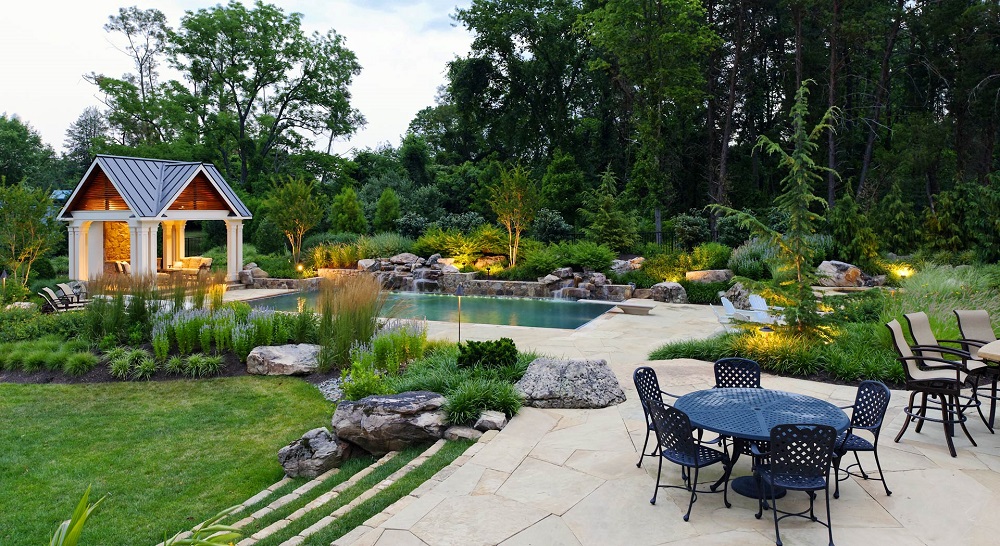We’re rapidly heading toward the part of spring when even the Northeast can look forward to the last slushy snow melting away and flowers starting to turn their faces toward the sun. Wherever in the country you live, you might enjoy this time of year because you can turn to your lawn and decide what projects appeal to you.
Landscaping is a personal choice, as some people like the way certain lawns and flowerbeds appear, while others might opt for something different. We’ve come up with some landscaping ideas that you might enjoy, so keep reading to see if any of these appeal to you.
Grass Selection
Experts say that you should keep your grass 2.5-3 inches high. You can keep that in mind in April when most people find it necessary to start cutting their lawns. However, you might find that you have some patchy places in your yard. That happens nearly every year, especially if you have a dog who likes to go out there to do his or her business.
Aside from what length you should keep your grass, though, you should also look at what kind of grass seed seems right when you hit the home and garden section of your local Lowe’s or Home Depot. There are plenty of different types of grass seed, and they are not necessarily interchangeable.
If you have trees overlooking your yard, you will probably have better results if you go with a grass seed that specifically says that it does well in both sun and shade. Some parts of your lawn might not see a great deal of sunlight, even on bright, cloudless days. The tree shade once the leaves come in may not get you the growth you want unless you get a grass seed variety that says it does well in those conditions.

Fertilizer
You can go through the process every spring of buying many heavy fertilizer bags and lugging them from the car into your backyard. As you get older, though, this process probably becomes less and less palatable. It won’t do your back any favors to drag thirty or even fifty-pound bags around to revitalize your flower beds.
You can create your own fertilizer pretty easily, though. That saves you all that physical labor, and it will save you some money as well.
One way you can create some natural fertilizer is by using your lawnmower in the autumn to pulverize any leaves that fall, rather than raking them up. That will save you the time and trouble of doing all that raking, and the leaf pulp will help your grass and flowers come back stronger the following year.
The leaf mulch will be nutrient-rich, and you won’t have to drag all of those leaf bags out to the curb. Plus, there’s something very satisfying about crunching through those leaves if you have a powerful lawnmower.
You can also get into creating fertilizer by composting. Some people let the concept intimidate them, but it’s not as complicated as you might imagine. There are a ton of articles and books online that can get you started. The soil you can produce when you compost will supercharge your flowerbeds just as well as anything you could buy in a home and garden store.
Consider an Irrigation System
Once we’re a little later into spring, and you’re thinking about watering your grass when there’s no rain predicted for a few days, you should think about installing an irrigation system if you don’t have one yet. This is something else that some people don’t want to do because they feel like it will be too complicated or expensive.
That’s not usually the case, though. Often, if you’re creative, you can set up an irrigation system rather cheaply that will water your lawn and flowers during dry spells.
You might install a dry well by digging a shallow trench with a hole about four feet by four feet square at the end of it. It should be at least 3-4 feet deep.
You can use that to collect any excess water accumulating in your basement during rainstorms. You can then divert that water into a sprinkler system to water your yard. If that seems like a bit too much work, you can also set up a rain barrel. You can use the water from that to water your yard and flowerbeds as well.

Weed Killers
If you have to deal with dandelions or other weeds during the spring months, that might frustrate you. Some weeds can be very stubborn, and they will come back again and again. If you use the more toxic chemicals from a home and garden center and spray them, you risk killing the grass that’s around them.
You can use natural weed killers instead that should not harm the surrounding grass. For instance, you can combine salt, white vinegar, and a little liquid dish soap. That should handle any weeds that pop up and spoil your lawn’s appearance.
Pebbles and Stones
Maybe you will want to add a little gravel path through your yard that ends in a fountain or a bird feeder. You can put down some landscaping fabric over the grass, dig a border on either side of it, and then put some pebbles down. You can get everything you need to do this at a home and garden center.
You can get a bird feeder to put at the end of the path to allow the birds to feed while keeping squirrels away. You might feel okay about feeding the squirrels. The problem is that once you’ve invited them into your garden, they will likely dig up your vegetables and flowers.
If you employ the techniques we mentioned, you should soon find your backyard and garden to be lovely places to spend some time. You might sit on the back porch in the evenings and watch the sunset while enjoying the fragrance and birdsong.






